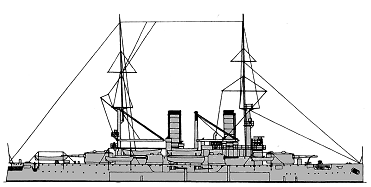

Tango 1911
| Name | No | Yard No | Builder | Laid down | Launched | Comp | Fate |
| 丹後 [Tango] (ex-Полтава [Poltava]) | New Admiralty, St. Petersburg, Russia | 19.5.1892 | 6.11.1894 | 30.8.1896 // 11.1911 | to Russia 4.1916 (Чесма [Chesma]) |
|
Displacement normal, t |
10960 |
|
Displacement full, t |
11500 |
|
Length, m |
108.7 pp 112.5 wl 114.3 oa |
|
Breadth, m |
21.3 |
|
Draught, m |
7.60 normal 7.90 full load |
|
No of shafts |
2 |
|
Machinery |
2 VTE, 16 Miyabara boilers |
|
Power, h. p. |
10600 |
|
Max speed, kts |
16.5 |
|
Fuel, t |
coal 1050 |
| Endurance, nm(kts) | 3750(10) |
|
Armour, mm |
belt 368 - 254, bulkheads: 229 - 203, Harvey steel: main turrets 254, main barbettes: 254, secondary turrets: 127, secondary barbettes: 127, nickel steel: deck 76 - 51, CT: 229 |
|
Armament |
2 x 2 - 305/38 (ru), 4 x 2 - 152/43 Canet, 6 x 1 - 76/40 41-shiki, 4 - 381 TT (aw, 1 bow, 1 stern, 2 beam), 50 mines |
|
Complement |
631 - 652 |
Project history: First Russian battleships built in homogenous class (but with different protection). Flush deck ships with appreciable tumblehome. All main and secondary guns were installed in French-type turrets. Poltava was sunk 5.12.1904 at Port Arthur by hits from Japanese 279mm howitzer shells, fell into Japanese hands 2.1.1905 and renamed Tango 21.7.1905. She was fully completed at Maizuru and really commissioned only in November 1911.
Ship protection: Main belt (73.2x2.29m) had 368mm thickness amidships between main gun barbettes (tapering to 184mm at lower edge) and 254mm abreast main gun barbettes inc short parts fwd from fwd and aft from aft barbettes. This belt was closed abreast main gun barbettes by 229mm fwd and 203mm aft transverse bulkheads. Upper belt (50x2.29m) between main gun barbettes had 127mm thickness and was closed by 127mm bulkheads, upper casemate between secondary barbettes had 76mm sides. Flat 51mm deck connected with upper edge of main belt. This deck had turtleback form outside citadel and had 63mm thickness near centerline and 76mm near sides. Main gun turrets had 254mm faces, sides and rears and 51mm roofs, secondary gun turrets had 127mm vertical and 25mm horizontal protection. Barbettes had 254- and 127mm sides respectively. CT had 229mm sides. Main belt was made from Krupp steel, turrets and barbettes were protected by Harvey steel, all other armour was made from nickel steel.
Modernizations: None.
Naval service: In 1909 Tango was re-rated as 1st class coast defence ship and served as training ship for seamen and gunners. In March 1916 she was returned to Russia and renamed Chesma.

Tango 1916
© Ivan Gogin, 2014